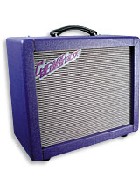
The latest creation from Dan Butler, of the Chicago-based Butler Custom Sound, is the Kingston. Available in 18- and 30-watt configurations, the Kingston is 1x 12 combo that features a Tone Tubby Brown Soun 12″ speaker, long-tank spring reverb, and has the ability to use a variety of output power tubes. The Kingston has inherited heavy duty construction and top-quality components from the Roadhouse, but in a smaller (20″ x 17″ x 9″), lighter (36 pounds) package. The pine cabinet features fingerjointed construction with a top-mounted stainless steel chassis with a hand-wired circuit employing Forbon eyelet boards, heavy-duty transformers, custom-made 1-watt resistors, and silver-plated wire. The Kingston’s all-tube circuit includes a 5AR4 rectifier, three 12AX7s in the preamp (one driving the reverb circuit), and two TAD 6L6 power tubes. The amp can also use a pair of 6V6s, 5881s, or EL34s (with proper re-biasing), and they don’t have to be a matched pair, since the amp incorporates dual bias controls (one for each power tube). In fact, you can mix and match power tubes (i.e. put a 6L6 in the first socket and an EL34 in the second socket), as long as the bias is set for each tube.
Controls on the Kingston include High- and Low-gain 1/4″ inputs, Volume, Bass and Treble controls, a Bright switch, and a switch for Harmonic Boost, Reverb, as well as the standard power and standby switches. Other notable features include an 18′ heavy duty power cord, extra large rubber feet, a 4-ohm external speaker output jack and a slave 1/4″ output jack with a padded speaker signal for running into another amp or processor.
Besides sharing the Roadhouse’s bullet-proof build, the Kingston has the same cool hot rod aesthetics and vibe. The combination of purple tolex, black piping and handle, salt-and-pepper grillecloth, purple mother of pearl inlay Q-part knobs, and purple jewel light, give it a distinct, well-conceived appearance that commands the popular response, “What a cool looking amp!”
But do those good looks equate to good tone? With our Fender Relic 1960 Strat and PRS McCarty in hand, I set out to see. With the Strat plugged into the high-gain input and the Tone and Volume controls set at straight up 12 o’clock, I discovered a clean, full tone with punchy midrange with just a hint of overdrive if I picked aggressively. Flipping the Bright switch added sizzle to the highs that brought out the Strat’s famous bell-like single-coil tones, while the Harmonic Boost switch not only added gain, but a bit of vigor to the amp’s entire audio spectrum – highs, mids and lows. The Treble control acted more like a midrange the further I turned it up, adding upper mids, while the Bright switch handled the highs. Like the Roadhouse, the Kingston responds exceedingly well to pick attack and a guitar’s volume and tone controls. There was no need to keep going to the amp to tailor my sound – I could do it all at the guitar.
Playing through the PRS humbuckers required dialing bass down a touch, to keep the speaker from bottoming out when driving the amp hard. The absence of a master volume means the Kingston has to be pushed hard to get its max overdrive tones; its 18 watts of output do get loud, but not uncontrollable or unfriendly onstage. Even cranked, with the Harmonic Boost switch on, and attacking pretty hard with my pick, the amp didn’t get overly distorted, which means it’ll serve up good blues overdrive with focused overtones.
To add more serious sustain and push, we dropped a Home Brew Electronics Power Screamer overdrive pedal into our signal chain. The combination of the PRS, the Power Screamer, and the Kingston produced an outstanding, very musical distortion that maintained note separation and clarity while spewing all the sustain and controllable feedback we wanted. Again, as with the Strat, I could clean up the PRS and soften the tone with just the volume and tone controls on the McCarty, so the lack of a master volume or channel switching isn’t a major concern with the Kingston. The tube-driven reverb has a snappy, shimmering sound, though it’s equipped with a slightly touchy depth control that could perhaps benefit from a potentiometer with a different taper. Still, the reverb is mere icing on the cake for the Kingston’s excellent tone.
The Kingston sounds as good as it looks, and with its straightforward design and rock-solid tone, it’s no wonder it and its CBB stablemates are being played by the likes of Ric Hall and his boss, Buddy Guy, as well as Omar Dykes, and Henry Garza of the Los Lonely Boys.
Chicago Blues Box Kingston
Features Hand-wired all-tube circuit with 6L6/6V6/5881/EL34 capability, 18 watts output, spring reverb, Tone Tubby Brown Sound 12″ speaker.
Price $2,400 (retail).
Contact Butler Custom Sound, 770 N. Church Rd, #I, Elmhurst, IL 60126; phone (630) 832-1983; chicagobluesbox.com.
This article originally appeared in VG‘s Oct. ’05 issue. All copyrights are by the author and Vintage Guitar magazine. Unauthorized replication or use is strictly prohibited.



